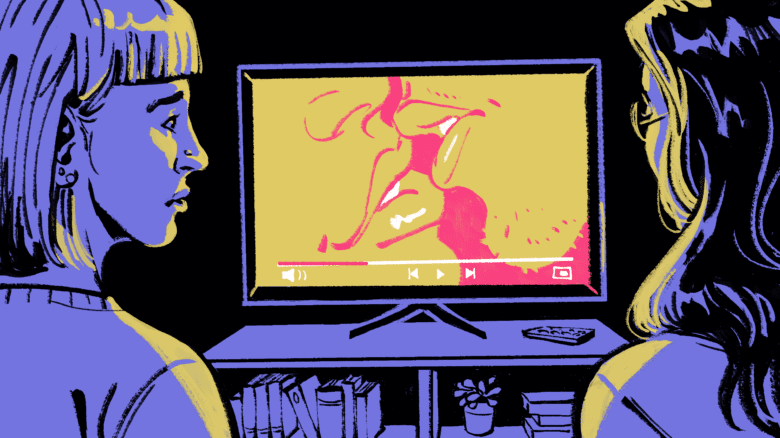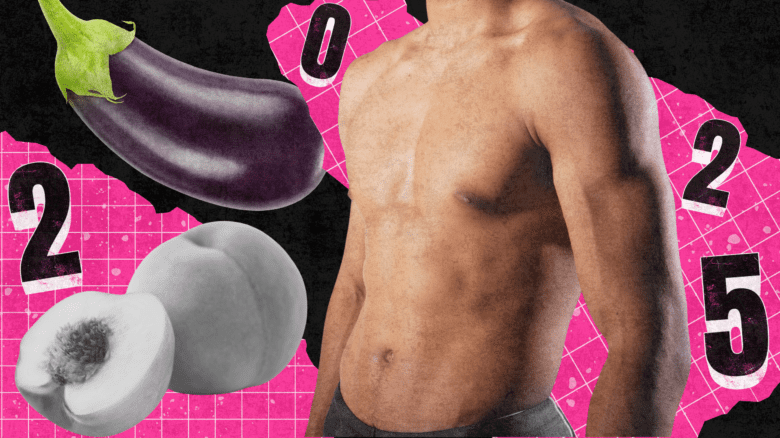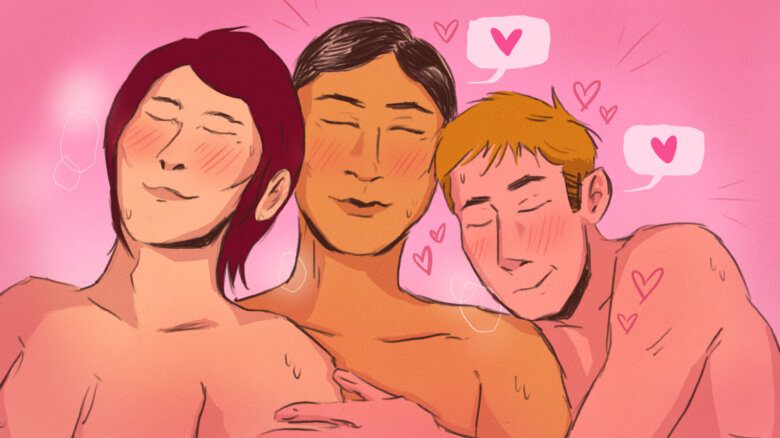I love face masks for saving countless lives, but they are seriously messing up my game. Since the COVID-19 pandemic began, I’ve started taking long, leisurely strolls (masked, of course) around the Castro District, San Francisco’s historic gaybourhood. As an internationally significant queer mecca with a robust history, the Castro is also an epicentre of unrelenting male cruising.
Such was the case on a Sunday in early July, when I spotted a handsome masked bear in the neighbourhood walking his dog toward me. As his dog stopped to say hello, I offered a good-natured smile. “You’re cute,” my eyes flashed. He stared sternly back. Or was he smiling too? No—I’m sure he was just staring. And so was I.
And that’s when I realized that, without the bottom half of his face, I was unable to interpret our prolonged eye contact. I couldn’t detect that familiar smirk signalling a curiosity or mutual interest. What’s worse, my facial cues were also obstructed. In the game of queer cruising, I was unarmed.
As the bear continued walking, I couldn’t help but feel that, because of our masks, we’d lost a point of potential connection; that, in the time of COVID-19, it feels like queers are starting to lose an age-old cruising language.
I’m not alone: Other queer men tell me they’re struggling with misreading the signs of pandemic cruising, too. “Folks don’t really get the full ‘desire’ face, so I look a little longer than I normally would,” says my friend Paolo Lopez, who I met on Grindr while visiting New York City. “Like, we’re not supposed to touch, but now we can’t even acknowledge we’re both cute either?”
“You’re just working with so much less information now,” adds another friend, Andrew Shaffer of San Francisco.
Add that mystery factor to the difficulties of cruising right now. With our collective shaming of Ian Frost’s shirtless ‘rona rave house parties in NYC to unmasked partygoers densely packing July Fourth Fire Island sex parties, there appears to be a broad consensus that now is just not an appropriate time to meet with people. (Though, if you decide to partake, we encourage doing so as safely as possible—by getting tested regularly and being honest and forthcoming about your results.)
“Today, cruising may just adapt to become a simple look: Conspicuous, attention-grabbing eye contact floating atop a sea of mouth-and-nose-covered masks”
But it’s not our out-of-control pandemic horniness that’s causing queers like me to continue cruising publicly despite the obvious health risks. Jaime Woo, Toronto-based writer and author of Meet Grindr, says it’s deeper than that. “We need to understand that people’s sense of self is also at risk,” he says. “You’re isolated at home, and a lot of your life touchpoints are lost because of COVID.
“Maybe going to the Eagle in Toronto is part of your identity. I haven’t gone to a cafe in months, and it feels like I’m losing my sense of self,” Woo says. “It’s that physicality, to touch someone, to fuck someone, that reminds us of who we are.”
In a queer community that privileges sexual capital, some of us are choosing to risk their personal health to cruise and feel a sense of validation and belonging in one another.
This same sense of validation, connection and belonging has at times been perilous to seek. We’ve seen, in our often virulently homophobic world, that queerness can beget violence. So, through the ages, queers have adapted, forging creative and clever ways to connect with, affirm and validate one other via pregnant subtext and plausible deniability. Today, cruising may just adapt to become a simple look: Conspicuous, attention-grabbing eye contact floating atop a sea of mouth-and-nose-covered masks.
In the 1950s, for instance, British and American queers employed the Polari language—a hodgepodge of 16th-century Italian, Mediterranean Lingua Franca, Romani and British and nautical slang once used by performers, sailors and social outcasts in the 1700s. Queers invoked Polari to dog whistle to other queers in public spaces without being detected by straights. Fluent speakers often conducted full-on conversations—asking, for example, “Charper charver” (Wanna fuck?)—while others casually dropped Polari terms like bona (good) and blag (pickup line) to covertly alert others to one’s queer identity. The language was replete with camp and irony, allowing queers to crystallize a shared fortitude and buoyant morale at a time when homosexuality was subject to derision, violence and arrest.
Queers of colour also developed their own tongues to codedly communicate. Scholar Martin F. Manalansan IV speculates that Swardspeak, an English and Tagalog amalgam, originated with beauty parlor workers in 1970s Manila. Scholars William Leap and Tom Boellstorff also found Javanese queers developed an even more esoteric language, wherein phrases like “kopi susu” (coffee with milk), doubled as “(ko)ntol (p)anjang (i)tu (s)angatk(u) (su)ka,” or: “I really like that big cock.”
With our keen fashion sense, it wasn’t long before cruising became encoded in dress. Queer leathermen in the 1970s developed the hanky code, a sartorial method of signalling queer identity and sexual fetish. “The colour of [one’s] bandana was associated with a specific sexual practice or fetish,” explains American historian J. Raúl Cornier. “The wearer’s sexual role was indicated by which back pocket the bandana resided in (tops wore bandanas in their left pocket; bottoms wore bandanas in their right pocket).” Red was the first hanky colour, sported by fisting practitioners, while other colour associations—like black for S&M and yellow for watersports—were later added.
“Queers persist—and they will continue, even with the unanticipated new obstacle of face masks”
Inspired by hanky code, lesbians later developed the key code. Following hanky code rules, lesbians carabiner-clipped their keys on their left belt loop to indicate top, or on the right to indicate bottom. The key code is said to have stemmed from butch womens’ attraction to the blue-collar masculine aesthetic, and continues to be depicted in popular media today.
With sodomy criminalized and nowhere to hook up, public parks and restrooms became common cruising grounds where interesting signals like “tapping” took root. Also known as “tea-rooming” in the U.S. (derived from “tea,” British slang for urine), “tapping” is when a cruiser occupies the stall farthest from the door and taps a foot under a shared stall divider to draw engagement. If the person in the next stall reciprocates, the two swipe their hands under the divider before eventually exposing themselves, or sharing a stall. In 1970s Manhattan, men cruising Bloomingdales restrooms would share stalls and cleverly conceal their feet by standing in a pair of shopping bags. The “tapping” tradition led to the creation and proliferation of glory holes—pierced holes in stall dividers through which men could engage in oral and/or anal sex. Since the B.C. Centre for Disease Control recently endorsed glory holes as a safe pandemic hook-up method, gay Twitter has seen a dramatic resurgence of #GloryHole, to complement the existing spike in “horny on main” social media posts.
Flash forward to 2020, and cruisers have largely transitioned to hook-up apps like Grindr, where desire is upfront and there’s much less need for coded language. Regardless, public cruising lives on, with “name-and-shame” police stings occurring regularly in major cities. Nevertheless, queers persist—and they will continue, even with the unanticipated new obstacle of face masks.
My NYC friend Paolo jokingly suggests hand gestures to get by—a throwback to the days of hanky codes and tapping. Others, like Andrew in San Francisco, take in stride the awkwardness of cruising in a mask. “Someone on the street was making eyes at me, so I made eyes back,” he recalls. “But when we got closer, I realized we’re already friends, and that’s why he was smiling!”
For generations, queer people have been gallant and creative. We have developed ways to share safety, connection and joy in the face of harrowing obstacles and overwhelming hostility. And if history is any indicator, our collective determination to get some will not be stymied by a thin veil of fabric.
“Queer cruising is not going away,” says Jaime Woo. “And neither is our need to connect.”

 Why you can trust Xtra
Why you can trust Xtra


